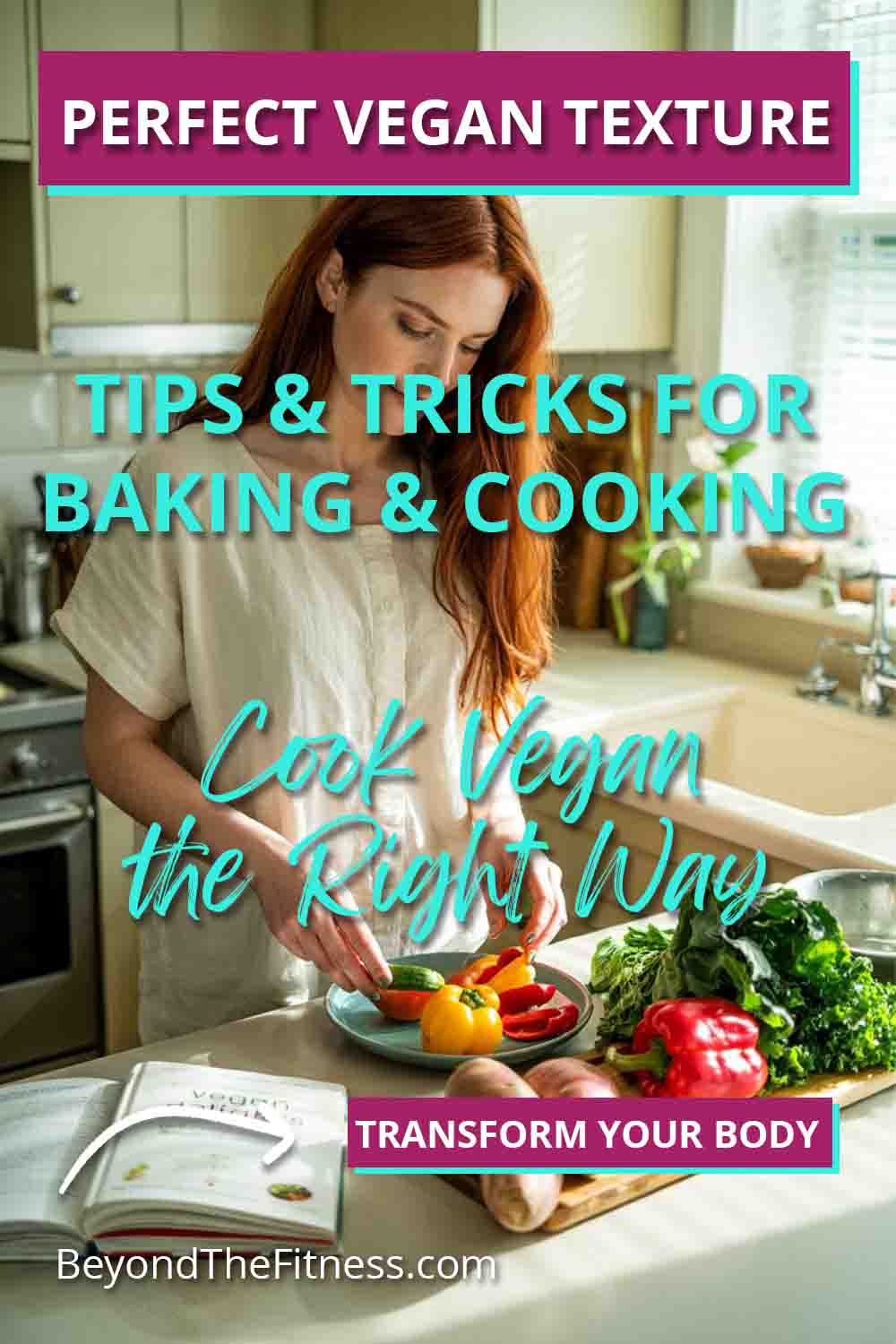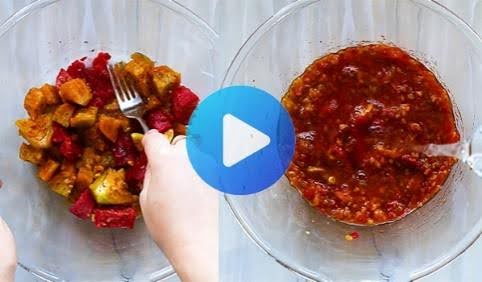Getting the texture right in vegan food can sometimes feel like a puzzle. When I first started exploring more plant-based meals as part of a healthy lifestyle, I noticed that sometimes things ended up a bit mushy, or maybe too dry. Texture is a huge part of enjoying food. Think about it – the creaminess of a sauce, the crispiness of a baked treat, the chewiness of a good bread. These feelings in our mouth make eating satisfying. When food is satisfying, we are more likely to stick with healthy eating habits, which is so important for reaching fitness goals and managing weight in a sustainable way. Making vegan food taste and feel great is key.
So, I dove deep into figuring out how to nail those textures without using animal products like eggs, butter, or dairy. It took some experimenting, but I found that with the right ingredients and techniques, you can create amazing vegan dishes with textures that rival traditional ones. This is great news because enjoying your food helps you stay on track with your health journey. Let’s explore some secrets I learned for getting perfect vegan texture in both baking and cooking.
Why Texture Matters So Much
Before we get into the how-to, let’s quickly talk about why texture is such a big deal. Food texture affects:
Insider Tip: Enjoying Healthy and Flavorful Plant-Based Dishes with The Complete Plant Based Recipe Cookbook
- How much we enjoy our food: A meal with different textures (like a salad with crunchy nuts and creamy avocado) is more interesting and enjoyable than something that’s all one consistency.
- How full we feel: Chewier foods often take longer to eat and can make us feel more satisfied. Creamy textures can feel comforting and rich. This feeling of satisfaction can help prevent overeating, which is helpful for weight management.
- Our perception of freshness: Crispy usually means fresh, while soggy often means old or poorly prepared.
- Nutrient absorption: Chewing food well, which is influenced by texture, starts the digestion process.
When we are aiming for a healthier lifestyle, especially focusing on weight loss or fitness, enjoying our meals is crucial. If healthy food feels boring or unpleasant texturally, it’s hard to stick with it long-term. Making vegan food texturally appealing helps ensure we get the nutrients we need from plants while truly enjoying the process.
Common Roadblocks in Vegan Texture
Sometimes, when you swap out animal products, you run into texture issues. Here are a few common ones:
- Baked goods being too dense or dry: Eggs add moisture, structure, and richness. Butter adds fat and helps create flaky or tender crumbs. Replacing them needs careful thought.
- Sauces lacking creaminess: Dairy milk and cream provide a specific richness and mouthfeel that plant milks alone might not replicate without help.
- Foods feeling mushy: Sometimes vegan burgers or loaves can lack a firm, satisfying bite.
- Lack of chewiness: Missing that satisfying chew you might get from meat or certain cheeses.
- Things not holding together: Eggs act as binders, helping ingredients stick together.
The good news is, for every challenge, there’s a vegan solution. It’s all about knowing which plant-based ingredients do what job.
Your Vegan Texture Toolkit: Key Ingredients
Think of these ingredients as your tools for building great texture. Understanding what each one does will help you choose the right ones for your recipe.
Healthy Fats for Richness and Flake
Fat plays a huge role in texture, especially in baking. It adds richness, tenderness, and sometimes flakiness. Choosing healthy fats is also great for overall well-being, supporting hormone health (very important for women) and keeping you feeling full.
- Coconut Oil: This is versatile. Solid, cold coconut oil can be cut into flour like butter to create flaky pastries or scones. Melted coconut oil adds moisture and richness to cakes and muffins. Choose refined coconut oil if you don’t want a coconut flavor.
- Avocado: Mashed avocado can replace butter or oil in some recipes, especially chocolate ones where its color won’t matter. It adds moisture and healthy fats. It can also be blended into creamy dressings or puddings.
- Nuts and Seeds (and their butters): Ground nuts (like almond flour) add structure and richness. Nut butters (peanut, almond, cashew) add fat, binding, and flavor. Whole nuts and seeds add crunch. Cashews, when soaked and blended, make incredibly creamy sauces and fillings.
- Vegan Butter: Many good vegan butters are available now. They are designed to behave like dairy butter in baking and cooking, making them great for cookies, cakes, and frostings where you want that buttery texture. Look for ones with a good fat content.
- Olive Oil and Other Vegetable Oils: Liquid oils add moisture to cakes and muffins, keeping them tender. Olive oil has a distinct flavor, while oils like canola or grapeseed are more neutral.
Binders to Hold Everything Together
Eggs do a lot in traditional recipes – they bind, add moisture, and help things rise. Here’s how to replace that binding action:
- Flax Eggs: Mix 1 tablespoon of ground flaxseed with 3 tablespoons of water. Let it sit for 5-10 minutes until it becomes gelatinous. This works well in muffins, cookies, and cakes. Flax is also a great source of fiber and omega-3 fatty acids.
- Chia Eggs: Similar to flax eggs, mix 1 tablespoon of chia seeds with 3 tablespoons of water and let sit. Chia seeds also provide fiber and healthy fats.
- Applesauce: Unsweetened applesauce can replace eggs (about 1/4 cup per egg) and some of the fat in baking. It adds moisture but can make things denser, so it’s best in recipes like muffins or quick breads.
- Mashed Banana: Like applesauce, about 1/2 a medium banana can replace an egg. It adds moisture and some binding, but also banana flavor. Good for pancakes, muffins, and banana bread.
- Starches: Cornstarch, arrowroot powder, or tapioca starch mixed with a little water can help bind sauces or fillings. They can also sometimes help in baking.
- Aquafaba: This is the liquid from a can of chickpeas. It sounds strange, but it whips up like egg whites. You can use it to make meringues, mousse, or add lightness to baked goods. About 3 tablespoons of aquafaba replaces one egg white.
Thickeners for Perfect Consistency
Nobody likes a watery sauce or a runny pie filling. These ingredients help thicken things up:
- Cornstarch: A common thickener. Mix it with a little cold water first (a slurry) before adding to hot liquids to avoid clumps. Needs to be cooked briefly to activate.
- Arrowroot Powder: Works like cornstarch but creates a glossier finish and thickens at a lower temperature. Good for fruit sauces.
- Tapioca Starch: Creates a slightly chewy or glossy texture. Often used in pie fillings.
- Agar-Agar: A seaweed derivative that acts like gelatin. It needs to be boiled to activate. Great for making vegan Jell-O, firm puddings, or panna cotta. Comes in flakes or powder.
- Xanthan Gum / Guar Gum: These are used in small amounts, often in gluten-free baking, to add structure and binding. They can also help thicken dressings or sauces without heating. Use sparingly as too much can make things gummy.
Leaveners for Lightness and Air
Leaveners create gas bubbles (usually carbon dioxide) in batters and doughs, making them rise and become light and airy.
- Baking Soda: Needs an acidic ingredient (like vinegar, lemon juice, molasses, brown sugar, or plant-based buttermilk – plant milk with a little vinegar added) to activate and create lift.
- Baking Powder: A complete leavener containing both an acid and a base. Most are double-acting, meaning they release gas once when mixed with liquid and again when heated.
- Yeast: Used in bread making. It feeds on sugars and releases carbon dioxide, causing dough to rise slowly.
Flours: The Foundation of Baked Goods
The type of flour you use dramatically impacts the final texture.
- All-Purpose Flour: The standard white flour. Creates reliable results but lacks the nutrients of whole grains.
- Whole Wheat Flour: Includes the bran and germ, adding fiber and nutrients but resulting in denser, heavier baked goods. Often best used in combination with all-purpose flour.
- Bread Flour: Higher in protein, developing more gluten for chewy breads.
- Cake Flour: Lower in protein, creating tender, delicate cakes.
- Gluten-Free Flours (Almond, Coconut, Oat, Chickpea, Rice, Buckwheat): Each has unique properties. Almond flour adds richness and moisture. Coconut flour is very absorbent and needs extra liquid. Oat flour gives a tender crumb. Chickpea flour has a distinct flavor, good for savory uses. Often, a blend of gluten-free flours works best. Choosing whole grain options like oat or buckwheat boosts fiber, supporting digestion and steady energy levels.
Plant Proteins for Structure and Bite
Getting enough protein is vital, especially when active or aiming for weight management, as it helps maintain muscle mass. Plant proteins can also provide fantastic textures.
- Tofu: Made from soybeans, tofu comes in different firmness levels.
- Silken Tofu: Soft and smooth, blends beautifully into creamy sauces, dressings, puddings, and smoothies.
- Firm/Extra-Firm Tofu: Best for cubing, crumbling, or slicing. Pressing out excess water is key for achieving a firmer, chewier, or crispier texture. It can be baked, fried, scrambled, or grilled.
- Tempeh: Fermented soybeans pressed into a cake. It has a firmer, chewier texture and a nutty flavor. Great marinated and then baked, steamed, or pan-fried. It holds its shape well.
- Seitan: Made from wheat gluten. It has a very chewy, meaty texture, making it a popular meat substitute. Good for stews, stir-fries, or making vegan “steaks” or “roasts.” (Not suitable for gluten-free diets).
- Lentils and Beans: Cooked lentils and beans can add texture and protein to loaves, burgers, soups, and stews. Red lentils break down easily, adding creaminess, while green or brown lentils hold their shape better for more texture. Beans add a soft but distinct texture.
Vegetables and Fruits: Nature’s Texture Builders
Don’t forget the power of produce.
- Mushrooms: Varieties like portobello or shiitake offer a savory flavor and meaty texture when cooked.
- Eggplant: Can become creamy when roasted or provide a tender bite in stews.
- Jackfruit: Young, green jackfruit has a stringy texture that mimics pulled pork or chicken when cooked and seasoned.
- Potatoes and Sweet Potatoes: Can be mashed for creaminess, roasted for crispiness, or boiled for a soft texture.
- Root Vegetables (Carrots, Beets): Add firmness and bite when roasted or used in stews.
- Pureed Vegetables: Butternut squash or cauliflower puree can add creaminess and nutrients to sauces.
Mastering Vegan Baking Textures
Baking without eggs and dairy requires a few adjustments to get those perfect textures.
Achieving Fluffy Cakes and Muffins
- Don’t Overmix: Mix batter just until the ingredients are combined. Overmixing develops gluten, leading to tough, dense results.
- Acid Power: Use an acid like apple cider vinegar or lemon juice with baking soda for extra lift. Making a “vegan buttermilk” (1 cup plant milk + 1 tsp vinegar, let sit 5 mins) works wonders.
- Sift Dry Ingredients: Sifting flour, baking powder, and baking soda helps incorporate air and prevents clumps.
- Room Temperature Ingredients: Cold ingredients don’t combine as well. Let plant milk and vegan butter sit out for a bit.
Keeping Things Moist
- Use Enough Fat: Don’t skimp on the oil or vegan butter called for in the recipe.
- Liquid Choices: Plant milks (soy, almond, oat), fruit purees (applesauce, banana), or even silken tofu blended in can add moisture.
- Avoid Overbaking: Check for doneness early. Baked goods continue cooking slightly as they cool. A toothpick inserted should come out with moist crumbs, not completely clean and dry.
Creating Crumbly Scones and Tender Cookies
- Cold Fat: For scones, biscuits, or pie crusts, use cold, solid vegan butter or coconut oil. Cut it into the flour until it resembles coarse meal. This creates pockets of fat that melt during baking, resulting in flakiness.
- Flour Matters: Using lower-protein flour like cake flour or pastry flour can lead to a more tender crumb in cookies and cakes.
- Sugar’s Role: Different sugars affect texture. Brown sugar adds moisture and chewiness, while white sugar contributes to crispness.
Getting Chewy Cookies and Bars
- Brown Sugar and Molasses: These ingredients attract moisture, contributing to chewiness.
- Oats: Rolled oats add a definite chewy texture to cookies and bars.
- Slightly Underbake: Pulling cookies out when the edges are set but the centers are still soft often results in a chewier final product after cooling.
- Higher Ratio of Wet to Dry: More liquid or fat relative to flour can increase chewiness.
Making Things Crispy
- Higher Sugar Content: Sugar caramelizes and helps create crisp edges.
- Thinner Batter/Dough: Spreading cookie dough thinner allows it to crisp up more easily.
- Baking Time and Temperature: Longer baking at a moderate temperature or shorter baking at a higher temperature can influence crispness. Experimentation might be needed.
- Cooling Method: Cooling cookies completely on a wire rack allows air to circulate, helping them crisp up.
Nailing Vegan Cooking Textures
Savory cooking also benefits greatly from attention to texture.
Achieving Luscious Creaminess
- Blended Raw Cashews: Soak raw cashews for a few hours (or boil for 10 minutes), then blend with water or plant milk until perfectly smooth. This makes amazing cream sauces, sour cream substitutes, or creamy soup bases.
- Silken Tofu: Blend it into smoothies, puddings, sauces, or dressings for a smooth, protein-rich creaminess.
- Coconut Milk/Cream: Full-fat canned coconut milk or coconut cream adds richness to curries, soups, and desserts. The flavor is noticeable, so use it where it complements other ingredients.
- Nutritional Yeast: While not exactly a thickener, it adds a cheesy, savory flavor that enhances the perception of richness in sauces or on vegetables.
- Potatoes or White Beans: Cooked potatoes or white beans (like cannellini) blended into soups or sauces add thickness and creaminess without much added fat.
- Vegetable Purees: Blended cooked cauliflower, butternut squash, or carrots can make soups and sauces creamy and nutrient-dense.
Creating Satisfying “Meaty” Textures
Making plant-based meals feel hearty and substantial often involves mimicking meaty textures.
- Press Your Tofu: Always press firm or extra-firm tofu to remove excess water. This allows it to absorb marinades better and achieve a firmer, chewier texture when cooked. You can press it using a tofu press or by wrapping it in towels and placing heavy objects on top.
- Marinate: Tofu, tempeh, and seitan benefit hugely from marinating. This infuses flavor and can help tenderize.
- Cooking Methods:
- Baking/Roasting: High heat can make tofu and tempeh chewy and slightly crispy on the outside.
- Pan-Frying/Searing: Creates a nice crust. Don’t overcrowd the pan.
- Grilling: Adds smoky flavor and grill marks.
- Crumbling: Crumble tofu or tempeh to mimic ground meat in sauces or tacos.
- Ingredient Choices:
- Seitan: Naturally very chewy and meat-like.
- Mushrooms: Especially portobellos or shiitakes, offer umami and chew.
- Lentils: Brown or green lentils hold their shape and provide a hearty base for loaves, burgers, or shepherd’s pie.
- Jackfruit: Young green jackfruit cooked in savory sauces shreds like pulled meat.
- Walnuts: Finely chopped or processed walnuts mixed with mushrooms and seasonings can create a ground meat texture.
Getting Things Crispy
Crispiness adds excitement to many dishes.
- Air Fryer Magic: An air fryer is fantastic for making crispy tofu, tempeh, potatoes, and vegetables with minimal oil.
- High Heat Roasting: Roasting vegetables or tofu at 400°F (200°C) or higher helps them brown and crisp up.
- Cornstarch Coating: Tossing tofu cubes or even vegetables like cauliflower in a little cornstarch before baking or frying creates a super crispy coating.
- Proper Pan-Frying: Use enough oil, get the pan hot before adding food, and don’t overcrowd the pan. This allows moisture to evaporate quickly, promoting crisping rather than steaming.
- Double Frying (Use Sparingly): For ultimate crispiness (like in some Asian tofu dishes), you can fry once, let cool slightly, then fry again briefly. This is less common for everyday healthy cooking but effective.
Adding Chewiness
Beyond seitan and tempeh:
- Cook Grains Al Dente: Don’t overcook pasta or whole grains like farro or barley. A slight bite adds pleasant chewiness.
- Dried Fruits: Adding raisins, cranberries, or chopped dates to salads, grain dishes, or baked goods provides chewy bursts.
- Dehydrated Vegetables: Sun-dried tomatoes have an intensely savory flavor and chewy texture.
Fixing Common Texture Problems
Sometimes things don’t go as planned. Here are quick fixes for common issues:
- My cake is too dense: Could be overmixing, not enough leavening, or the wrong balance of wet/dry ingredients. Try adding a teaspoon of vinegar to activate baking soda next time, or gently fold ingredients.
- My cookies spread too much: The dough might be too warm, or there might be too much fat or liquid. Try chilling the dough for 30 minutes before baking. You might need to slightly increase the flour next time.
- My tofu is soggy: You probably didn’t press it enough. Pressing is crucial. Also, ensure your cooking heat is high enough (baking, frying) to evaporate moisture.
- My sauce is too thin: Whisk in a cornstarch slurry (1 tbsp cornstarch + 2 tbsp cold water) and simmer gently until thickened. Or, blend in some soaked cashews or a bit of silken tofu.
- My sauce is too thick: Simply whisk in a little more liquid (water, broth, plant milk) until it reaches the desired consistency.
- My bread is too crumbly: Might need more binder (like a flax egg) or more fat/moisture. If gluten-free, it might need a binder like xanthan gum or psyllium husk.
Texture Makes Healthy Eating Sustainable
Mastering vegan texture isn’t just about making food taste good; it’s about making healthy eating enjoyable and sustainable. When your plant-based meals are satisfying, with appealing creaminess, crispiness, or chewiness, you are far less likely to feel deprived or reach for less healthy options. This is incredibly important when you are focused on fitness, weight management, or simply improving your overall health.
By using whole-food ingredients like nuts, seeds, beans, lentils, tofu, tempeh, fruits, and vegetables to create these textures, you are also packing your meals with fiber, vitamins, minerals, and protein. It’s a win-win: delicious food that supports your body and your goals. Experimenting with these tips and ingredients will open up a whole new world of delicious and texturally exciting vegan possibilities.
You Might Be Interested In: Exploring Delicious Vegan Recipes With This Cookbook
Related YouTube Video
For more ideas on delicious vegan eating, you might find this video helpful:
Final Thoughts
Learning to control texture in vegan cooking and baking has been a game-changer for me. It transformed meals from simply being “plant-based” to being truly delicious and satisfying. It showed me that eating healthy doesn’t mean sacrificing enjoyment. Whether it’s a creamy pasta sauce made with cashews, a crispy baked tofu that rivals any fried food, or a perfectly moist and fluffy vegan cake, getting the texture right makes all the difference. It helps me stay excited about my food, stick to my health goals, and feel great. I hope these tips empower you to experiment in your own kitchen and discover the joy of texturally amazing vegan food.







